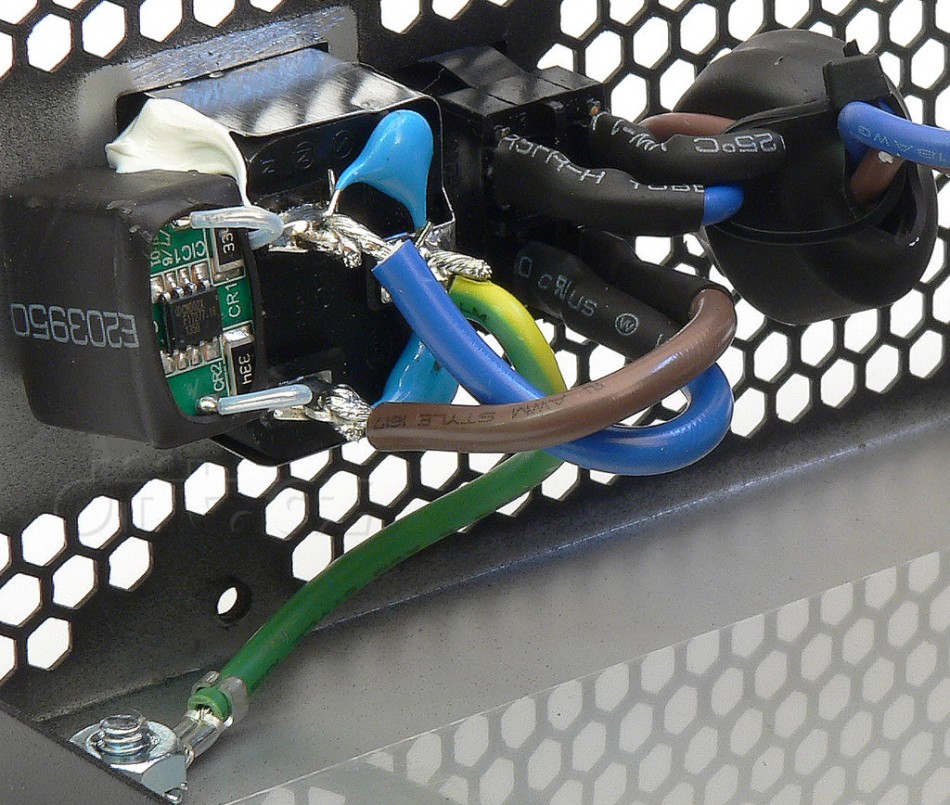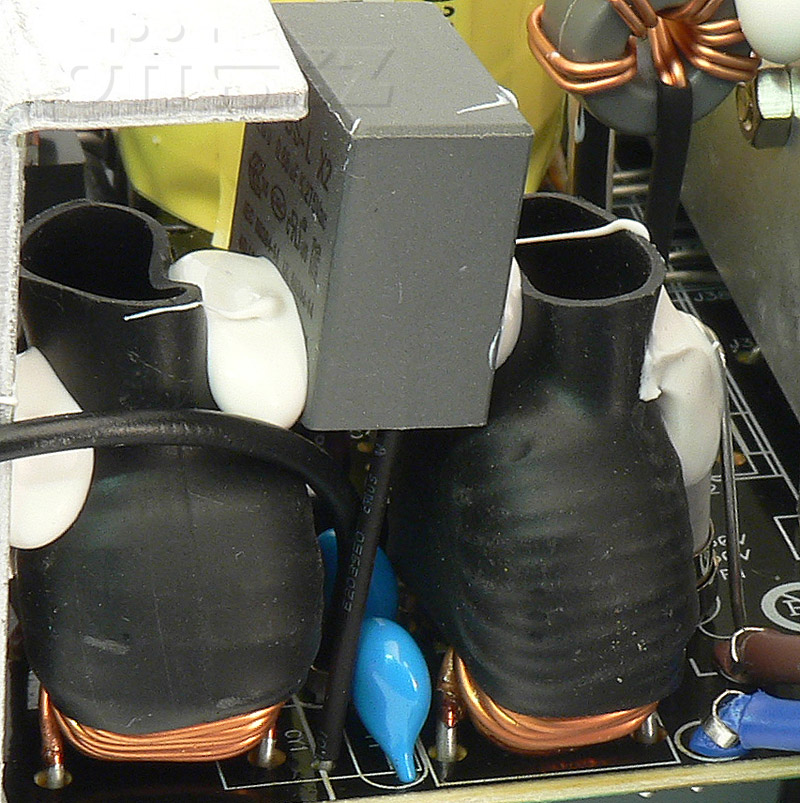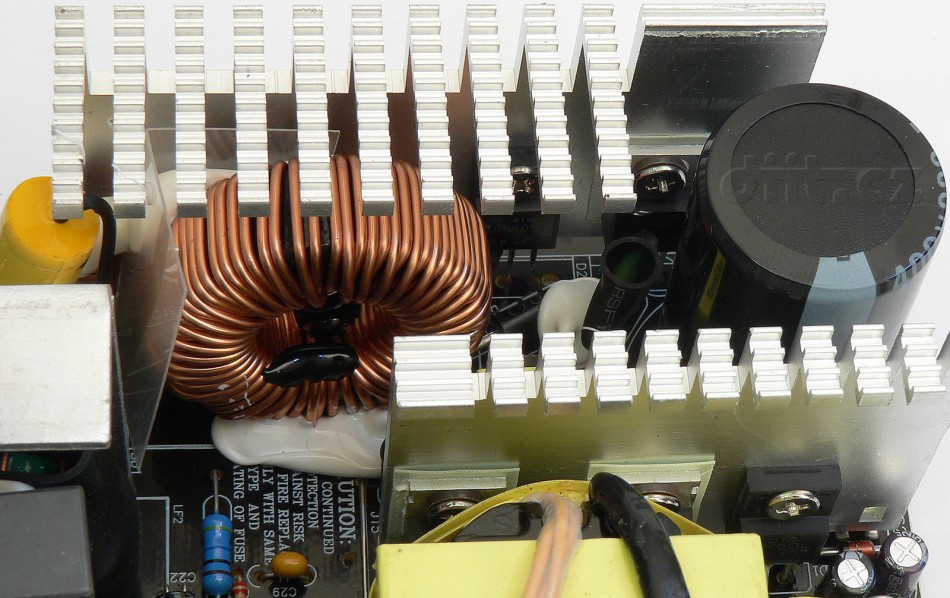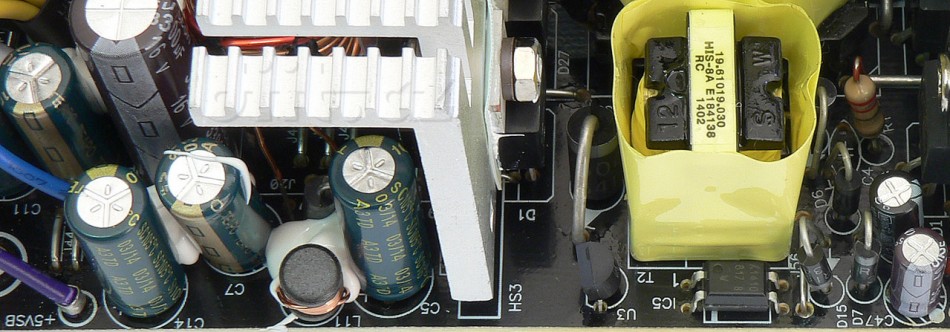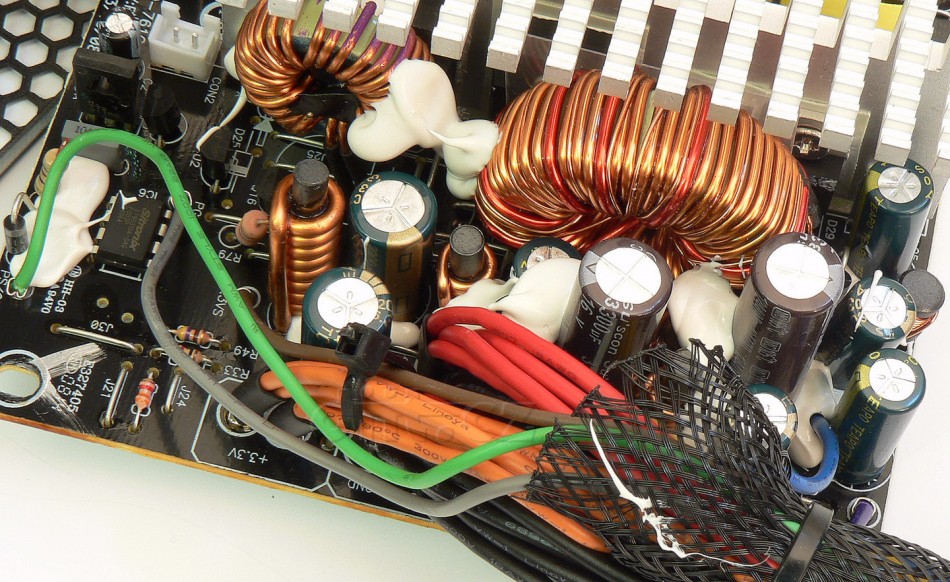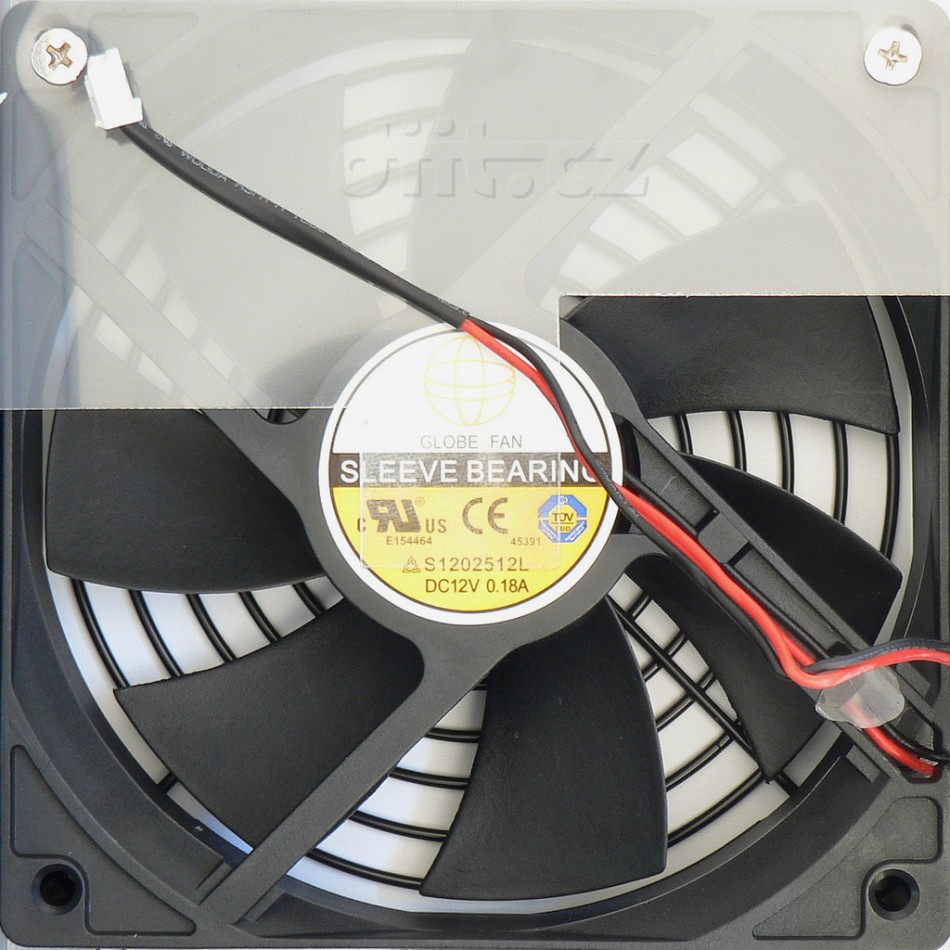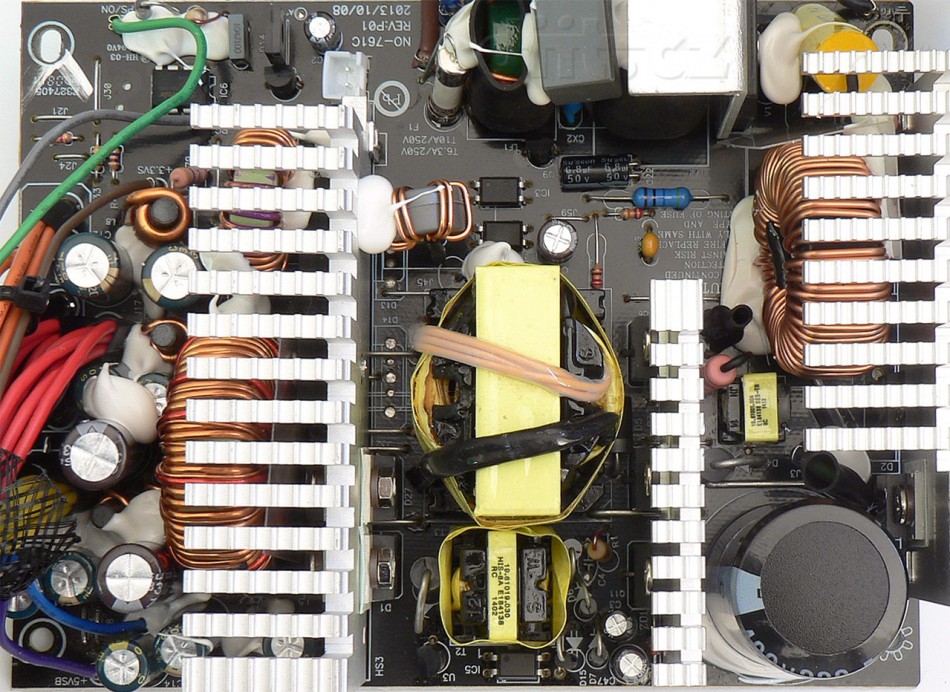Disassembly
The input filtering starts at the AC receptacle with an X and two Y capacitors. The small PCB soldered to the X cap contains a CMD02X IC, which disconnects the discharge resistors when AC power is connected, saving a small amount of power. The AC wires pass through a ferrite bead after the double-pole switch. The main PCB adds another X cap, two Y caps, two common-mode chokes and an MOV, so the total component count is two X and four Y capacitors, two common-mode chokes, a ferrite bead and an MOV, which is enough components. This section of the power supply is fairly well insulated, with the coils and the legs on the X caps covered with heatshrink.
A GBU1006 bridge rectifier is used on the input. It can handle up to 10 A continuously and 220 A surge, at 800 V and 100 °C, while forward voltage drop is 1.1 V per diode. It is screwed to its own heatsink, with no thermal grease. There are two PFC transistors mounted on the biggest heatsink with fins that extend over the PFC coil. They are Fuji Electric FMP20N60S1 (20/60 A at 25 °C and 600 V, switched-on resistance (Rds(On)) 190 mΩ at 10 A) in TO-220F package. The diode for passing voltage peaks to the capacitor is an NXP Semiconductor BYC10-600 (10 / 20 A at 78 °C and 600 V, drop of 2.9 V at 25 °C and 10 A) in TO-220AC package. The PFC capacitor is a Teapo LH 330 μF/400 V, which is rated for only 2000 hours life at 85°C. There is room for improvement here – the capacitance is a bit on the low side for a 600W unit, and it would also be preferable to use a part rated for a higher voltage (like 420V or 450V) and for 105°C.
The heatsink for the switching transistors (in usual two-transistor forward topology) is somewhat smaller than the PFC section heatsink. Besides the +5VSB section (which we’ll get to in a second), there are two Magnachip MDF18N50B (18 A/72 A at 25 °C and 500 V, Rds(On) 270 mΩ at 9 A) Transistors in TO-220F package. They are controlled by a Champion Micro CM6805BG in SSOP-10 package. Even though this IC is a PFC and PWM controller combo, it appears that the PFC section was not used, in favour of a dedicated CM03X PFC controller. They should operate together at 67.5 kHz. The PFC contains current limiting (which could be used as over-power protection) using an ordinary resistor shunt.
The 5VSB rail has a single transistor, driven by a tiny 6-pin controller on the solder side, which we were not able to identify. The transistor is a Unisonic Technologies 2N60L (2 A continuous/8 A pulsed at 600 V and 25 °C) power MOSFET in TO-220F casing.
The 12 V rail uses four PFR30L60CT rectifiers (30A average current, 250A surge at 60 V and 25 °C, loss of 0.6 V at 15 A and 25 °C) in TO-220 package, mounted in parallel. The 3.3 V and 5 V rails have the same rectifiers as each other, in each case a single MOSPEC S30D45C (30/300 A at 45 V and 125 °C, loss of 0.55 V at 15 A and 25 °C) in TO-247 package. They are mounted, as usual, together with 12V rectifiers to a single secondary-side heatsink of similar size to the PFC one. The secondary side is monitored by a Sitronix ST9S313A-DAG IC, which can only turn the unit on, generate Power Good and provide Under/Over-Voltage protection on three rails, with its 8 pins. It does not support Over-Current Protection.
 The secondary side capacitors are a mix of Su’scon MC and Teapo SC. We will have to take some points off there – those parts are not exactly what we would call good quality.
The secondary side capacitors are a mix of Su’scon MC and Teapo SC. We will have to take some points off there – those parts are not exactly what we would call good quality.
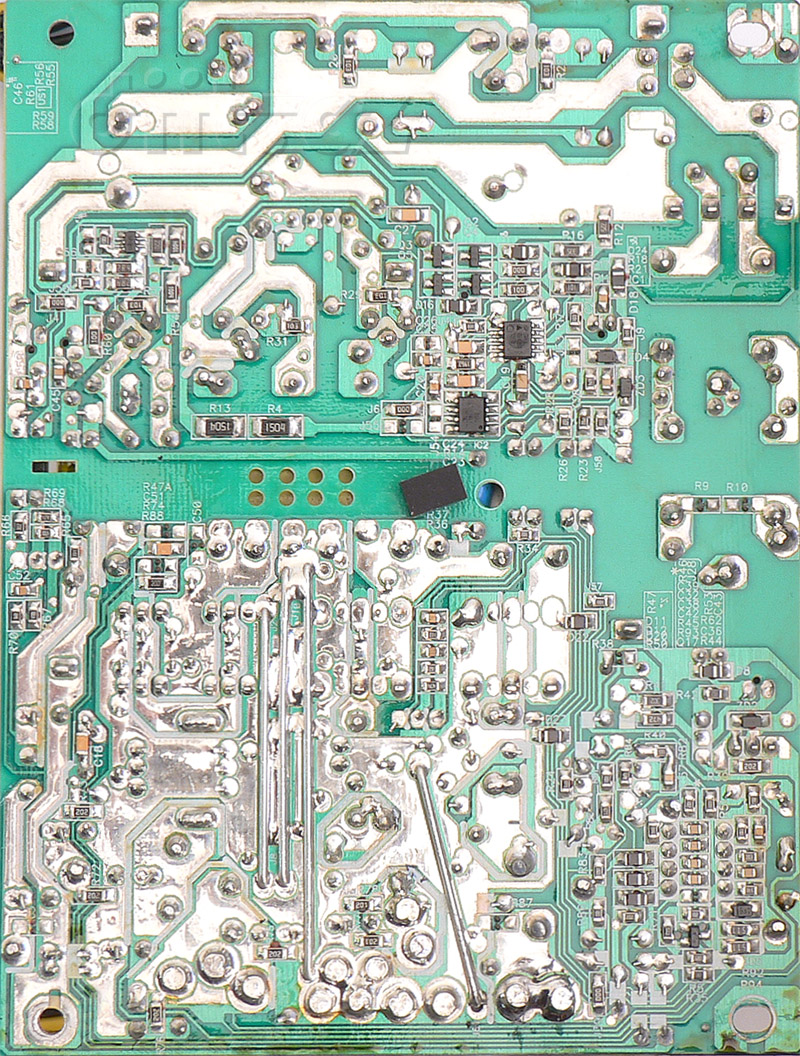 The soldering quality is quite decent. The high current paths are well reinforced with extra jumper wire and (with the exception of that one skewed jumper wire at the the bottom end, which is not overly critical), the joints are all tidy, have an appropriate amount of solder, and the component pins are cut to appropriate lengths. The primary and secondary side separation is good, and there are some holes under the main transformer and stand-by rail optocoupler. But there could have been more spacing between the AC line paths and low-voltage driving circuitry on primary side. There is also some residual solder flux along one edge of the PCB. These issues are so minor, though, that we won’t take any points off for this.
The soldering quality is quite decent. The high current paths are well reinforced with extra jumper wire and (with the exception of that one skewed jumper wire at the the bottom end, which is not overly critical), the joints are all tidy, have an appropriate amount of solder, and the component pins are cut to appropriate lengths. The primary and secondary side separation is good, and there are some holes under the main transformer and stand-by rail optocoupler. But there could have been more spacing between the AC line paths and low-voltage driving circuitry on primary side. There is also some residual solder flux along one edge of the PCB. These issues are so minor, though, that we won’t take any points off for this.
A Globe Fan S1202512L is used for cooling – a 12cm sleeve bearing fan. The maximum speed is 2000 RPM with airflow of 67.3 CFM and noise rating of 34 dBA. The back half of the fan is covered by the usual plastic airflow baffle. The heatsinks are reasonably sized for a unit like this, although the switching transistor heatsink could probably have used a few larger fins.
